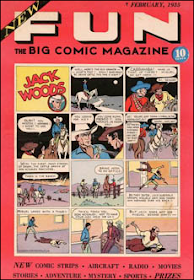New Fun with Jack and Bill
In 1935, National Publications issued its first magazine collection of original comics. New Fun was thus the first comic book from the company founded by Malcolm Wheeler-Nicholson that eventually became DC Comics.
That magazine basically tried to replicate a Sunday newspaper comics section. It was as large as a tabloid newspaper. Though the interior was all black and white, the company quickly moved to color printing, suggesting that was always the plan.
Most significant for the storytelling, the magazine offered twenty different comics, each on a single page. (Twelve more interior pages were filled with prose and advertising.) Some of those comics ended in gags, but most were serialized adventures. Most were also obvious knock-offs of popular newspaper strips or genres. The stories were aimed at different audiences, from little kids to adults looking for thrills.
The advertising reflected that same hope that the magazine would appeal to a broad audience. There were ads for model airplanes, for example, but also ads for job seekers. There were multiple ads for razor blades, indicating that the publisher expected a significant portion of the readers to be shaving. Some ads were aimed at men and a few at women. As National Publications narrowed its target audience to kids, some of those ads went away while others stuck around for decades.
One of the latter was for Charles Atlas’s bodybuilding lessons. From the start Atlas built his campaign around the graphic story of “The Insult that Made a Man out of ‘Mac’.” A scrawny young man gets humiliated in front of a girl on the beach, builds up his muscles, and returns to beat up that bully—in front of more admiring girls. The art was later redrawn, but the script didn’t change much.
One New Fun page turn later, however, came another bodybuilding ad built around another little story, but with a different message. The Jowett Institute of Physical Culture titled its comic “Jack ‘Puts One Over’ on His Boy Friend!” Girls appear in only half of its six panels (instead of seven out of nine in the Charles Atlas story). The relationship between Jack and his pal Bill is more developed than the one between Jack and Hannah. The institute also offered a “FREE Book with Photos of Famous Strong Men.” A different sort of appeal.
That magazine basically tried to replicate a Sunday newspaper comics section. It was as large as a tabloid newspaper. Though the interior was all black and white, the company quickly moved to color printing, suggesting that was always the plan.
Most significant for the storytelling, the magazine offered twenty different comics, each on a single page. (Twelve more interior pages were filled with prose and advertising.) Some of those comics ended in gags, but most were serialized adventures. Most were also obvious knock-offs of popular newspaper strips or genres. The stories were aimed at different audiences, from little kids to adults looking for thrills.
The advertising reflected that same hope that the magazine would appeal to a broad audience. There were ads for model airplanes, for example, but also ads for job seekers. There were multiple ads for razor blades, indicating that the publisher expected a significant portion of the readers to be shaving. Some ads were aimed at men and a few at women. As National Publications narrowed its target audience to kids, some of those ads went away while others stuck around for decades.
One of the latter was for Charles Atlas’s bodybuilding lessons. From the start Atlas built his campaign around the graphic story of “The Insult that Made a Man out of ‘Mac’.” A scrawny young man gets humiliated in front of a girl on the beach, builds up his muscles, and returns to beat up that bully—in front of more admiring girls. The art was later redrawn, but the script didn’t change much.
One New Fun page turn later, however, came another bodybuilding ad built around another little story, but with a different message. The Jowett Institute of Physical Culture titled its comic “Jack ‘Puts One Over’ on His Boy Friend!” Girls appear in only half of its six panels (instead of seven out of nine in the Charles Atlas story). The relationship between Jack and his pal Bill is more developed than the one between Jack and Hannah. The institute also offered a “FREE Book with Photos of Famous Strong Men.” A different sort of appeal.




1 comment:
Dynamic tension!
Post a Comment